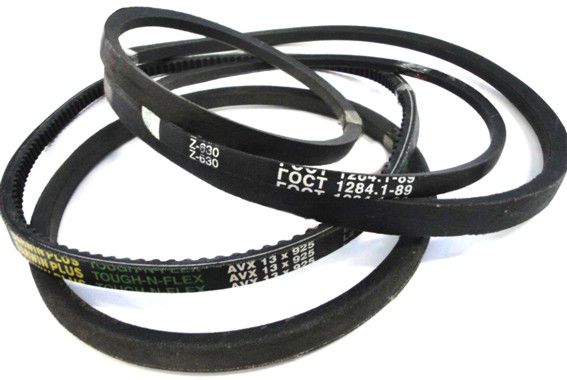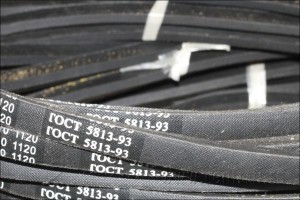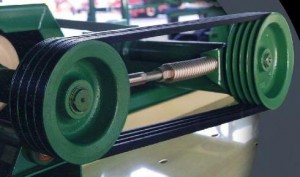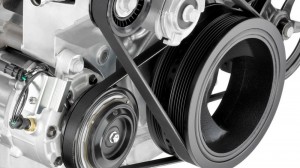Gears based on rubber V-belts are widely used to drive engine units and in transmissions of various equipment. Read all about drive V-belts, their existing types, design features and characteristics, as well as the correct selection and replacement of belts in the article.
Purpose and functions of V-belts
A drive V-belt (fan belt, automobile belt) is a rubber-fabric endless (rolled into a ring) belt of trapezoidal (V-shaped) cross-section, designed to transmit torque from the crankshaft of the power plant to mounted units, as well as between various units of road, agricultural machines, machine tools, industrial and other installations.
The belt drive, known to man for more than two millennia, has several drawbacks, among which the greatest problems are caused by slippage and mechanical damage under high loads. To a large extent, these problems are solved in belts with a special profile - V-shaped (trapezoidal).
V-belts have a wide range of applications:
● In the power plants of automobile and other equipment for the transmission of rotation from the crankshaft to various devices - a fan, a generator, a power steering pump and others;
● In transmissions and drives of self-propelled and trailed road, agricultural and special equipment;
● In transmissions and drives of stationary machines, machine tools and other equipment.
Belts are subjected to intense wear and damage during operation, which reduces the reliability of the V-belt transmission or completely disables it. To make the right choice of a new belt, you should understand the existing types of these products, their design and characteristics.
Please note: today there are V-belts and V-ribbed (multi-strand) belts that have different designs. This article describes only standard V-belts.

Driven V-beltsV-belts
Types of drive V-belts
There are two main types of V-belts:
- Smooth drive belts (conventional or AV);
- Timing drive belts (AVX).
The smooth belt is a closed ring of trapezoidal cross-section with a smooth working surface along the entire length. On the working surface of the (narrow) timing belts, teeth of various profiles are applied, which give the belt increased elasticity and contribute to the extension of the life of the entire product.
Smooth belts are available in two versions:
- Execution I - narrow sections, the ratio of a wide base to the height of such a belt lies in the range of 1.3-1.4;
- Execution II - normal sections, the ratio of a wide base to the height of such a belt lies in the range of 1.6-1.8.
Smooth belts can have nominal design widths of 8.5, 11, 14 mm (narrow sections), 12.5, 14, 16, 19 and 21 mm (normal sections). It is necessary to indicate that the design width is measured below the wide base of the belt, so the above dimensions correspond to the width of the wide base of 10, 13, 17 mm and 15, 17, 19, 22, 25 mm, respectively.
Drive belts for agricultural machinery, machine tools and various stationary installations have an extended range of base sizes, up to 40 mm. Drive belts for power plants of automotive equipment are available in three sizes - AV 10, AV 13 and AV 17.

Fan V-belts

V-belt transmissions
Timing belts are available only in Type I (narrow sections), but the teeth can be of three variants:
● Option 1 - wavy (sinusoidal) teeth with the same radius of the tooth and interdental distance;
● Option 2 - with a flat tooth and a radius interdental distance;
● Option 3 - with a radius (rounded) tooth and a flat interdental distance.
Timing belts come in only two sizes - AVX 10 and AVX 13, each of the sizes is available with all three tooth variants (so there are six main types of timing belts).
V-belts of all types are manufactured in several versions according to the properties of static electricity charge accumulation and climatic zones of operation.
According to the properties of the accumulation of electrostatic charge, belts are:
● Ordinary;
● Antistatic - with a reduced ability to accumulate charge.
According to climatic zones, belts are:
● For areas with a tropical climate (with operating temperatures from -30 ° C to + 60 ° C);
● For areas with a temperate climate (also with operating temperatures from -30 ° C to + 60 ° C);
● For areas with a cold climate (with operating temperatures from -60 ° C to + 40 ° C).
The classification, characteristics and tolerances of V-belts of various types are regulated by domestic and international standards, including GOST 5813-2015, GOST R ISO 2790-2017, GOST 1284.1-89, GOST R 53841-2010 and related documents.
Post time: Jul-10-2023

